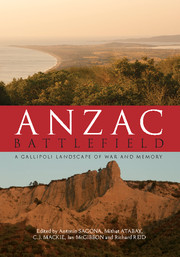Book contents
- Frontmatter
- Foreword
- Contents
- Figures
- Plates
- Contributors
- Acknowledgements
- Abbreviations
- Gallipoli battlefield place names
- Introduction
- 1 Boundary and divide: The antiquity of the Dardanelles
- 2 The Gallipoli campaign: History and legend
- 3 Recording the battlefield: First steps
- 4 Capturing the battlefield: Mapping and air photography at Gallipoli
- 5 Battlefield archaeology: Gallipoli
- 6 Forming the ANZAC battlefield
- 7 Forming the Ottoman battlefield
- 8 Artefacts from the battlefield
- 9 Remembering Gallipoli
- 10 Remembering Gallipoli from a Turkish perspective
- Conclusion
- Appendix Anzac Gallipoli Archaeological Database
- References
- Index
Appendix - Anzac Gallipoli Archaeological Database
Published online by Cambridge University Press: 05 December 2015
- Frontmatter
- Foreword
- Contents
- Figures
- Plates
- Contributors
- Acknowledgements
- Abbreviations
- Gallipoli battlefield place names
- Introduction
- 1 Boundary and divide: The antiquity of the Dardanelles
- 2 The Gallipoli campaign: History and legend
- 3 Recording the battlefield: First steps
- 4 Capturing the battlefield: Mapping and air photography at Gallipoli
- 5 Battlefield archaeology: Gallipoli
- 6 Forming the ANZAC battlefield
- 7 Forming the Ottoman battlefield
- 8 Artefacts from the battlefield
- 9 Remembering Gallipoli
- 10 Remembering Gallipoli from a Turkish perspective
- Conclusion
- Appendix Anzac Gallipoli Archaeological Database
- References
- Index
Summary
The Anzac Gallipoli Archaeological Database is a unique and detailed record of the information recovered during the JHAS field project. Its value is the documentation of archaeological contexts, thereby enabling features and artefacts to be studied in association. During the project, information was collated and managed in a Geographic Information System (GIS) and research database that includes searchable attributes about each feature and artefact. One outcome of the JHAS has been to make this database available to other researchers and the general public as a web-based, digital archive – the Anzac Gallipoli Archaeological Database (AGAD; <www.arts.unimelb.edu.au/gallipoli-battlefield>) – which is comprehensive in its content. It is an important and complementary resource for this book, as many of the features and artefacts that could not be included or illustrated in the text can be found online in AGAD.
AGAD occupies a unique space among the increasing number of digital archaeological gazetteers, archives and catalogues on web-based platforms that are being constructed as an effective way of making primary data available to a wide audience. With more than 2000 records precisely documented in the field, it aims to assist the study of the First World War through its emphasis on landscape and artefacts. The database is organised around the features and artefacts documented in the GIS, rather than specific sites or locations. The feature entries are of the various types used during the JHAS surveys (see table A.1). Each feature is given a unique Feature ID (and artefacts have an additional catalogue ‘Artefact Number’). Moreover, each feature has a record that displays data attributes, including a description, dimensions, chronological period, location and find-spot information, survey date, associated features, artefact type, material type, preservation rating and between one and three images, such as photographs and maps. Artefacts form a major portion of the archive, as they are the largest group of features recorded, and a separate set of artefact types is identified in the data set. It includes information documented in both Turkish and Anzac-held areas of the battlefield, providing an insight into the battlefield from perspectives on both sides of the conflict.
Feature types have been categorised from observations in the field. Eleven feature types are c. 1915 battlefield features (artefacts, boats, six types of earthworks, graves, roads, structures).
- Type
- Chapter
- Information
- Anzac BattlefieldA Gallipoli Landscape of War and Memory, pp. 246 - 250Publisher: Cambridge University PressPrint publication year: 2016

